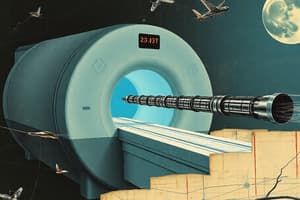Podcast
Questions and Answers
What is the primary material used in the cooling process of MRI machines to achieve superconductivity?
What is the primary material used in the cooling process of MRI machines to achieve superconductivity?
- Liquid oxygen
- Liquid nitrogen
- Liquid argon
- Liquid helium (correct)
What is a typical volume of liquid helium required for an MRI scanner?
What is a typical volume of liquid helium required for an MRI scanner?
- 3,000 liters
- 500 liters
- 1,700 liters (correct)
- 2,500 liters
During which phase of operation is capturing boil-off helium gas particularly important?
During which phase of operation is capturing boil-off helium gas particularly important?
- Energy saving pre-cooling
- Magnet ramp down
- Magnet ramp up to full field (correct)
- Normal operating condition
What temperature is typically achieved for superconductivity in MRI magnets?
What temperature is typically achieved for superconductivity in MRI magnets?
What is the role of the cryostat in an MRI machine?
What is the role of the cryostat in an MRI machine?
Which of the following best describes the environmental conditions maintained around the superconducting magnet in an MRI machine?
Which of the following best describes the environmental conditions maintained around the superconducting magnet in an MRI machine?
What advanced cooling method is being developed for MRI applications?
What advanced cooling method is being developed for MRI applications?
What is one of the challenges in the design of MRI superconducting coils?
What is one of the challenges in the design of MRI superconducting coils?
What technology is used for cooling magnets in MRI systems?
What technology is used for cooling magnets in MRI systems?
What principle does laser cooling primarily use to reduce atomic temperature?
What principle does laser cooling primarily use to reduce atomic temperature?
How does an atom moving toward a laser beam interact with the photons in laser cooling?
How does an atom moving toward a laser beam interact with the photons in laser cooling?
What happens when a stationary atom interacts with a laser that is neither red-shifted nor blue-shifted?
What happens when a stationary atom interacts with a laser that is neither red-shifted nor blue-shifted?
What is the purpose of having four temperature sensors on the superconducting magnet?
What is the purpose of having four temperature sensors on the superconducting magnet?
What is a potential result if light is applied from two opposite directions in laser cooling?
What is a potential result if light is applied from two opposite directions in laser cooling?
What is the relationship between temperature and the lifetime of a laser system used for cooling?
What is the relationship between temperature and the lifetime of a laser system used for cooling?
What is the role of the second stage in the dual-stage cryocooler?
What is the role of the second stage in the dual-stage cryocooler?
Flashcards
MRI Magnet Cooling
MRI Magnet Cooling
Cooling MRI magnets to extremely low temperatures using liquid helium to maintain superconductivity and minimize resistance in wires.
Superconductivity
Superconductivity
A state of matter where electrical resistance is almost zero, allowing efficient current flow without energy loss.
Liquid Helium
Liquid Helium
The cryogenic fluid used to maintain the superconductive state of MRI magnets. It boils at very low temperatures.
Cryocooler
Cryocooler
Signup and view all the flashcards
Cryostat
Cryostat
Signup and view all the flashcards
Magnet Ramp Up/Down
Magnet Ramp Up/Down
Signup and view all the flashcards
Helium Boil-off
Helium Boil-off
Signup and view all the flashcards
Operating Mode
Operating Mode
Signup and view all the flashcards
Cryocooler Technology
Cryocooler Technology
Signup and view all the flashcards
Dual-Stage Cryocooler
Dual-Stage Cryocooler
Signup and view all the flashcards
Laser Cooling System (LCS)
Laser Cooling System (LCS)
Signup and view all the flashcards
Doppler Effect in Laser Cooling
Doppler Effect in Laser Cooling
Signup and view all the flashcards
Superconducting Magnet Cooling
Superconducting Magnet Cooling
Signup and view all the flashcards
Temperature Sensors (MRI)
Temperature Sensors (MRI)
Signup and view all the flashcards
Laser Wavelength Control
Laser Wavelength Control
Signup and view all the flashcards
Helium Reliquefaction
Helium Reliquefaction
Signup and view all the flashcards
Study Notes
Magnetic Resonance Imaging (MRI)
- MRI machines use super-conducting magnets and coils to generate a powerful magnetic field.
- Maintaining this field requires significant energy, achieved through superconductivity which minimizes wire resistance.
- Superconductivity is achieved by immersing the coils in super-cooled liquid helium at -269.1°C.
- A typical MRI scanner utilizes 1,700 liters of liquid helium, requiring periodic refills.
- Recent innovations include small refrigerators designed for helium recondensation, resulting in a closed refrigeration system.
Cooling of Magnets
- MRI machines rely on liquid helium for superconductivity.
- The cryostat, housing the magnet assembly, features a vacuum case and thermal shield.
- The cryocooler, often vertical, is designed for fitting into the cryostat's sleeve.
- Liquid helium filling level (1500-2000 liters) is crucial for maintaining superconductivity.
- Temperature gradients within the magnet can impact the minimum allowable volume for optimal operation.
- Modern MRI systems require pre and post-cooling techniques to operate in various modes (e.g., using liquid nitrogen or recoverable liquid helium).
Shape of MRI Machines
- MRI machines come in closed and open designs.
- Closed MRI machines offer a compact and enclosed tunnel-like shape.
- Open MRI machines provide an open design, improving patient comfort and accessibility.
Comparison Between MRI Machines
| Feature | Closed MRI | Open MRI |
|---|---|---|
| Magnetic Field Strength | Typically 1.5T – 3T | Typically 0.2T – 0.4T |
| Image Quality | Higher | Lower |
| Imaging Speed | Faster | Slower |
| Applications | More advanced | More limited |
| Patient Anxiety | Higher | Lower |
| Claustrophobia | More challenging for claustrophobic patients | Easier for claustrophobic patients |
| Acoustic Noise | Higher | Lower |
Studying That Suits You
Use AI to generate personalized quizzes and flashcards to suit your learning preferences.




